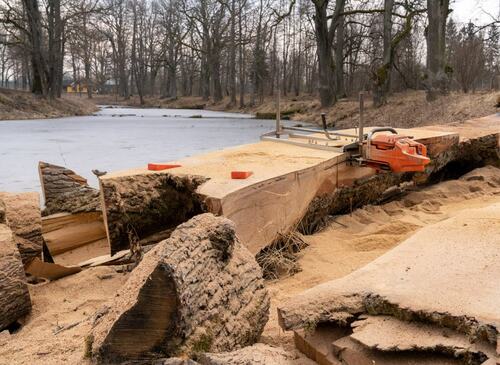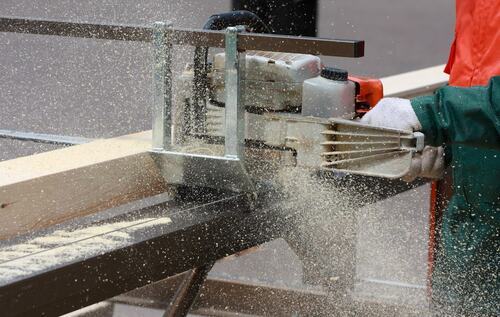Portable Sawmill Safety: Essential Tips and Precautions
Introduction
What’s better than a sawmill? A portable sawmill, of course!
A portable sawmill can be a great choice for folks looking for a cheaper source of lumber, those interested in utilizing the timber resources of their own woodlot or farm to whip up a supplemental stream of property-based revenue, and for smaller-scale commercial milling operations . The machine gives both professional and hobbyist sawyers the ability to process lumber at multiple sites—including remote areas from which it’s hard to extract logs—or to establish a permanent or semipermanent mill setup on a property and turn out a wide variety of cuts for all sorts of applications and markets.
It goes without saying that bringing the mill to the logs rather than the other way around—as you get to do with a portable mill setup—cuts majorly down on transport costs. Indeed, portable sawmills can be a pretty pocketbook-friendly way to generate your own lumber with low up-front and operating costs. And if you want to scale up at some point, you can always add another portable sawmill to the equation!
Throw in the sustainability element—portable sawmills generally have a smaller footprint than larger industrial mills and eliminate the heavy environmental impacts of hauling logs out of a rural, primitive, or wild area—and it’s easy to see why more than a few homesteaders, farmers, loggers, and craftspeople end up buying (or building) a portable sawmill.
To get the most out of your portable sawmill—and to protect not only yourself but also the equipment—proper setup is essential. While it’s imperative to follow the specific instructions provided by your mill’s manufacturer, we’ve pulled together some general tips on portable sawmill safety and setup below that we hope you’ll find useful.
Choosing the Right Location & Preparing the Site

A Portable Sawmill Site on a Riverbank
You’ll want as level and clear ground as you can manage for your portable sawmill plus enough room and clearance to transport and accommodate the mill as well as bring in, stage, and load logs. If you’re using an electric sawmill as opposed to one fueled by gas or diesel, proximity to a power source is obviously going to be a consideration.
Portable Mill Site Preparation
You may need to trim branches and clear brush to make it feasible for trailers, tractors, loaders, and other rigs to access the site. If possible, avoid setting up your staging site for logs—which should be set atop planks or some other platform to make grabbing and loading quicker and easier—downhill of the sawmill. It just makes things easier if you can (carefully and in a controlled manner, of course) partner with gravity to move logs up onto the sawmill.
You can either set your portable sawmill on the ground or, as many do, mount it onto a trailer for maximum mobility. If you do position it on the ground, you might use anything from beams, skids, or cinder blocks to a concrete pad for a stable “foundation” under the sawmill. Many users elevate the sawmill a bit to make it easier to load and operate.
Assembling the Sawmill
Given the variety of sawmill brands and designs out there, we’re not going into specifics in terms of step-by-step portable sawmill assembly and installation—we’ll simply emphasize the (hopefully obvious!) importance of following the manufacturer’s instructions exactly so that you’re putting things together for efficient, effective, and safe operation.
Leveling the Bed

An Arborist Now Expert Carefully Sets Up a Portable Sawmill
Efficient cutting on a portable sawmill demands that its bed or track is level. Things will naturally get out of whack as you break down and reestablish the sawmill at another site and through the expected bumping and banging that goes along with loading logs (which, nonetheless, you’ll want to keep to a minimum for safety and to reduce wear and tear on your equipment).
Ensuring your sawmill track is level means you’ll be cutting on the desired flat plane and helps you correctly position and orient your blade and log stops. Use a basic spirit level, laser level, water level, or whatever your preferred, reliable leveling aid is to guide your adjustment of the portable sawmill’s bed.
Setting Up the Log Support System
Employ that leveling aid of yours to ensure the sawmill’s crosswise log bunks also lie on a flat plane. If your mill has adjustable log stops, use a carpenter’s square or level to square them up with the bed.
Blade Installation, Tensioning, & Tracking
The main kinds of portable sawmills include bandsaw and circular saw (including swing-blade) varieties as well as simple and inexpensive—but not as effective—chainsaw mills. Portable bandsaw mills , which offer the thinnest blade kerfs and are very well suited for cutting small logs, are probably the most popular all-around.
The kind of wood (e.g., softwoods vs. hardwoods) and the diameter of the logs you’re processing will guide what sort of bandsaw blade profile you ought to choose. Components of blade profile you need to consider include the hook and back angles and the height and spacing of your saw teeth.
When it comes to blade tensioning for portable mills, follow manufacturer specifications to achieve the proper tension. You can use a dial caliper or specialized blade tension gauge to check where you’re at on that front.
Depending on the mill model, you’ll generally want your blade at full tension for blade tracking adjustment. Adjust your blade guides so that the blade runs without touching them for the most part (though a little contact is generally fine). Leveling aids help ensure your blade runs parallel to the sawmill track.
Dust Collection

A Portable Sawmill Spraying Sawdust While in Use
It goes without saying that having a system in place to deal with the sawdust that hard-working portable mill of yours churns out is imperative. Many sawmill manufacturers sell chutes and dust collectors customized for compatibility with specific mill models.
Part of dust management for portable sawmills is making sure you’ve chosen the right blade for the kind of lumber you’re working with: Make sure the tooth height of your blade allows for adequate sawdust removal through the gullet.
Sawmill Safety Setup
Nothing’s more important when milling your own lumber than portable sawmill safety. Be sure all sawmill shields and guards are properly installed, and never operate the mill without them. Test and periodically check the sawmill’s emergency shutoff switch to make sure it’s working.
Arborist Now: Your San Francisco Bay Area Milling Experts
Here at Arborist Now, we have extensive experience with not only pruning, felling, and otherwise dealing with Bay Area trees, but also milling green lumber from wood that might otherwise go to waste. If you have questions about operating a portable sawmill—or would like expertly cut wood from a local, sustainable source—don’t hesitate to reach out to our team!


